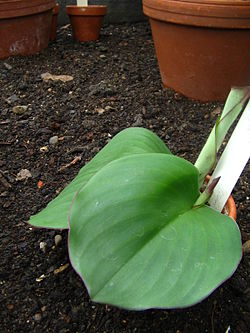
Karena jahe hanya bisa bertahan hidup di daerah tropis, penanamannya hanya bsia dilakukan di daerah katulistiwa seperi Asia Tenggara, Brasil, dan Afrika. Saat ini Equador dan Brasil menjadi pemasok jahe terbesar di dunia.
Ciri morfologis
Batang jahe merupakan batang semu dengan tinggi 30 hingga 100 cm. Akarnya berbentuk rimpang dengan daging akar berwarna kuning hingga kemerahan dengan bau menyengat. Daun menyirip dengan panjang 15 hingga 23 mm dan panjang 8 hingga 15 mm. Tangkai daun berbulu halus.
Bunga jahe tumbuh dari dalam tanah berbentuk bulat telur dengan panjang 3,5 hingga 5 cm dan lebar 1,5 hingga 1,75 cm. Gagang bunga bersisik sebanyak 5 hingga 7 buah. Bunga berwarna hijau kekuningan. Bibir bunga dan kepala putik ungu. Tangkai putik berjumlah dua.
Pengolahan dan pemasaran
Rimpang jahe, terutama yang dipanen pada umur yang masih muda tidak bertahan lama disimpan di gudang. Untuk itu diperlukan pengolahan secepatnya agar tetap layak dikonsumsi.
Terdapat beberapa hasil pengolahan jahe yang terdapat di pasaran, yaitu:
Jahe segar
Jahe kering
Awetan jahe
Jahe bubuk
Minyak jahe
Oleoresin jahe
Jahe kering
Merupakan potongan jahe yang kemudian dikeringkan. Jenis ini sangat populer di pasar tradisional.
Awetan jahe
Merupakan hasil pengolahan tradisional dari jahe segar, terutama jahe muda. Yang paling sering ditemui di pasaran adalah acar, asinan, sirup, dan kristal jahe. Jenis ini disukai konsumen dari daerah Asia dan Australia.
Bubuk jahe
Merupakan hasil pengolahan lebih lanjut dari jahe menggunakan teknologi industri. Bubuk jahe diperlukan untuk keperluan farmasi, minuman, alkohol dan jamu. Biasanya menggunakan bahan baku jahe kering.
Oleoresin jahe
Adalah hasil pengolahan lebih lanjut dari tepung jahe. Bentuknya berupa cairan cokelat dengan kandungan minyak asiri 15 hingga 35%.
Habitat
Jahe tumbuh subur di ketinggian 0 hingga 1500 meter di atas permukaan laut, kecuali jenis jahe gajah di ketinggian 500 hingga 950 meter.
Untuk bisa berproduksi optimal, dibutuhkan curah hujan 2500 hingga 3000 mm per tahun, kelembapan 80% dan tanah lembab dengan PH 5,5 hingga 7,0 dan unsur hara tinggi. Tanah yang digunakan untuk penanaman jahe tidak boleh tergenang.
Varietas
Terdapat tiga jenis jahe yang populer di pasaran, yaitu:
Jahe gajah
Merupakan jahe yang paling disukai di pasaran internasional. Bentuknya besar gemuk dan rasanya tidak terlalu pedas. Daging rimpang berwarna kuning hingga putih.
Jahe kuning
Merupakan jahe yang banyak dipakai sebagai bumbu masakan, terutama untuk konsumsi lokal. Rasa dan aromanya cukup tajam. Ukuran rimpang sedang dengan warna kuning.
Jahe merah
Jahe jenis ini memiliki kandungan minyak asiri tinggi dan rasa paling pedas, sehingga cocok untuk bahan dasar farmasi dan jamu. Ukuran rimpangnya paling kecil dengan warna merah.dengan serat lebih besar dibanding jahe biasa.
Produk jahe
Di masyarakat barat, ginger ale merupakan produk yang digemari. Sementara Jepang dan Tiongkok sangat menyukai asinan jahe. Sirup jahe disenangi masyarakat Tiongkok, Eropa dan Jepang.
Di Indonesia, sekoteng, bandrek, dan wedang jahe merupakan minuman yang digemari karena mampu memberikan rasa hangat di malam hari, terutama di daerah pegunungan.






